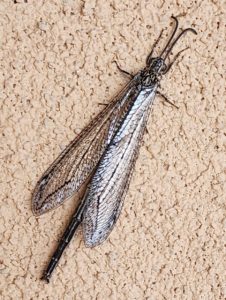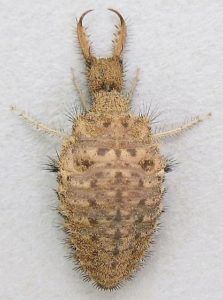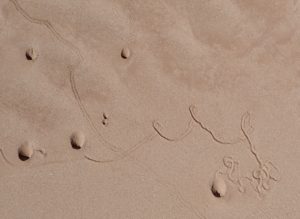APRIL: Invertebrate of the Month

Family Myrmeleontidae photo by Christie Collins
Antlion: The Stealthy Hunter
Myrmeleon sp.
Have you ever been standing or walking along our dry, sandy soil and noticed a pattern of tiny, cone shaped craters? They look a lot like craters left from rain drops falling from the eaves of a building. You’ve discovered a “pit of despair” for unsuspecting prey of a tiny but mighty predator, the antlion larva.
The pits are actually called pit traps and are typically about 1 to 2 inches deep. The larva waits patiently just beneath the surface, at the tip of the cone shaped deathtrap. Their long pincers are poised just below the surface waiting for an insect to slide down the sides of the loose, sandy slope. When they’ve snatched their prey, the larva drags it under the soil surface to dine slowly by extracting the fluids from inside of their prey.

Antlion larvae, photo by Jim Moore
The scary looking larvae (something out of a horror movie) are called doodlebugs. This is because of the “doodling” tracks they leave in the sandy soil as they zigzag from pit to pit, only capable of scurrying backwards from pit to pit.
Exploring the life cycle of the antlion the longest stage is during the larval stage which can last up to three years! Once they are ready to metamorphosize into the next stage of adult, they spin a silk cocoon mixed with the sandy soil they live in and are buried underground for up to a month during the transformation.
As an antlion emerges from its cocoon, they display beautifully decorated intricate wing venation and long bodies. They have transformed from voracious day hunters to nectar sipping nocturnal diners. In their adult stage they only live for about 30-45 days.
The next time you see several little craters on the ground, take a moment to see if you can witness the quick grab of an unlucky bug in the pit of despair.

Doodling by Doodle bugs Photo by Dicklyon


